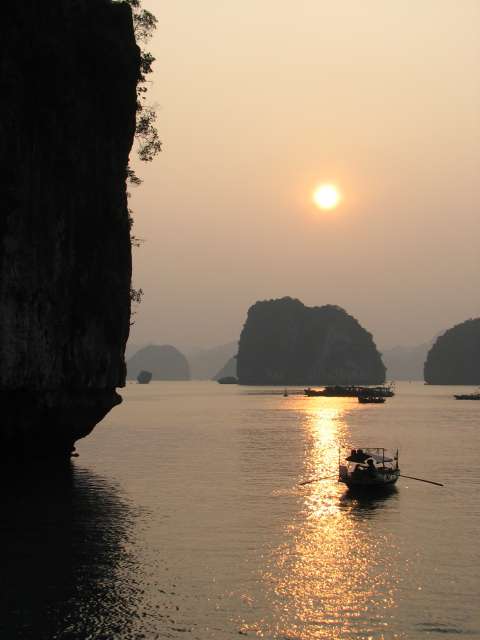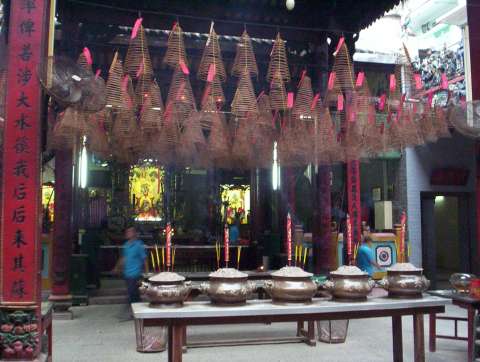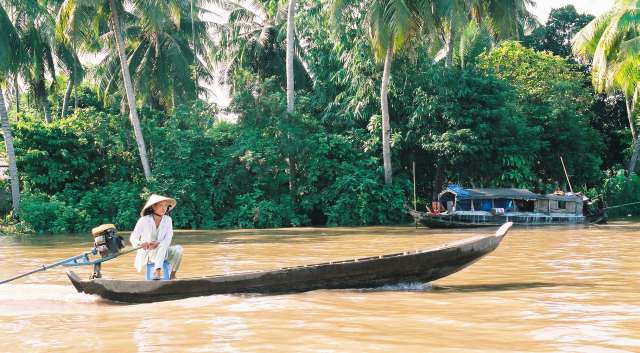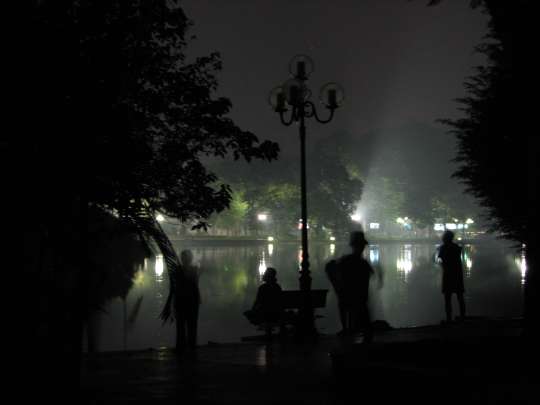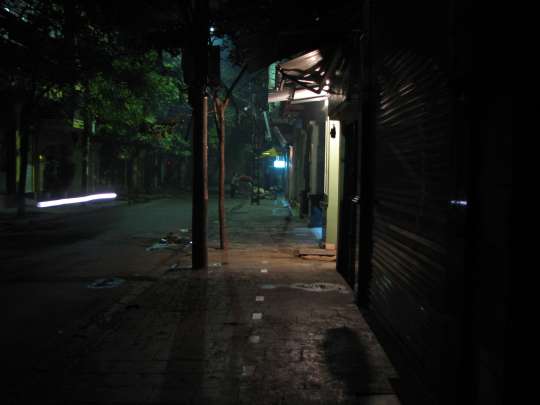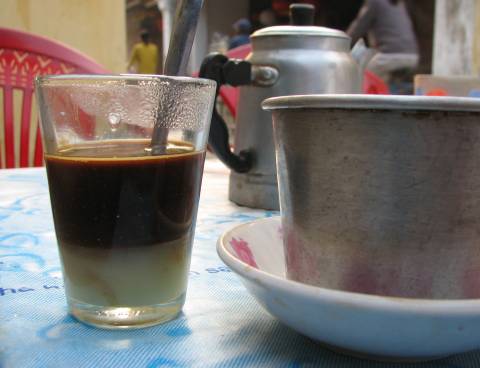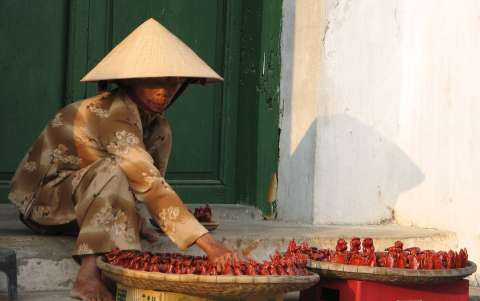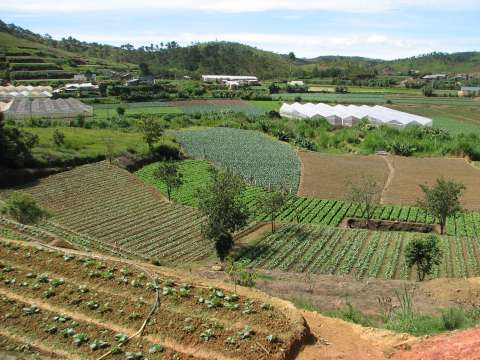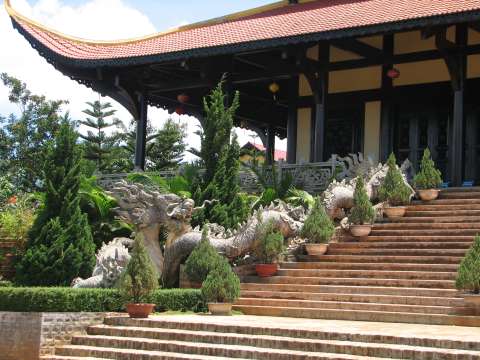River traffic and river-bank houses near the floating market
Photo 2004/10/03
| |
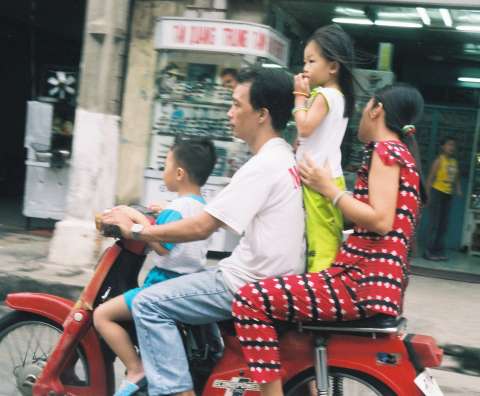
| |
Four on a scooter is not an unusual sight anywhere in a Vietnamese city,
although not easy to capture on a photo.
| |
|

| |
Crossing the busier streets in Ho Chi Minh can be a bit daunting until
you get used to it.
| |
|
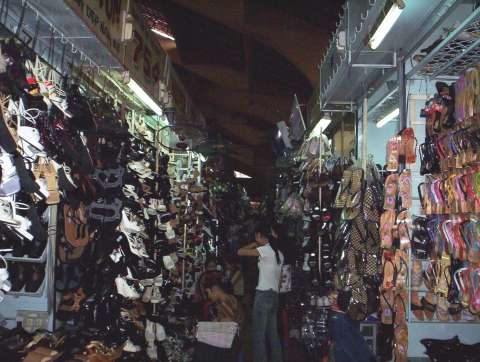
| |
A very small part of a market in the Pham Ngu Lao area of Ho Chi Minh.
All the larger cities in Vietnam have very well stocked markets where
prices are very low and, it seems, you can buy almost anything.
Some of the most interesting, and cheapest, eating is available in the
markets, although language can be a major problem.
|
|
Commonly called Saigon outside of Vietnam, but officially Ho Chi Minh
City, this is the biggest city in the country and the commercial hub.
(Officially, Saigon is a relatively small section of Hi Chi Minh City.)
You can pay a lot for accommodation, or you can get a very pleasant and
comfortable air conditioned double room with en-suite bathroom and toilet
for around Aust$20 per night (including breakfast).
We stayed at Hotel 64 in both 2004 and 2006.
General shopping opportunities are probably Vietnam's best, or at least
most extensive, in Saigon.
A miner ally in a busy Ho Chi Mihn market
| |
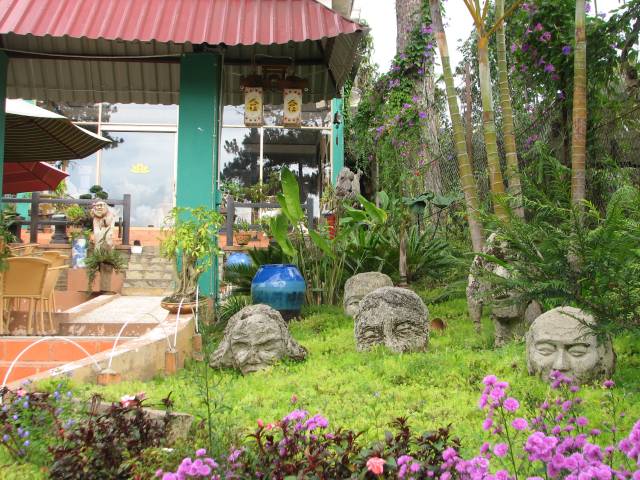
| |
A part of the excellent vegetarian restaurant Phien Tinh Tien,
17 Huynh Thuc Khang street, Dalat
|

| |
Vintage motorbike in Restaurant de Famille; one of many restaurants
with excellent food
|
A bakery photographed from both ends.
It was on the river that runs parallel to Phan Dinh Phung street.
I just happened to notice the beautiful fresh bread as I walked past the door.
It seems to use waste wood as fuel for its ovens.
Delicious fresh bread from a very ordinary looking source. |
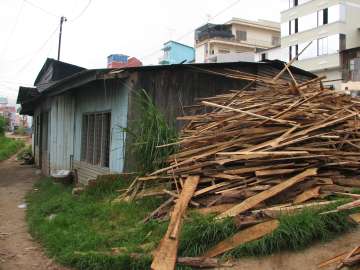
|

|
Part of Dalat market.
Most of it is in the buildings on the right side of the photo.
Note the pastel colours of the buildings in the background; very typical of
Vietnam.
Also interesting is the Araucaria tree; (right of centre) these were fairly common in the Dalat area. |
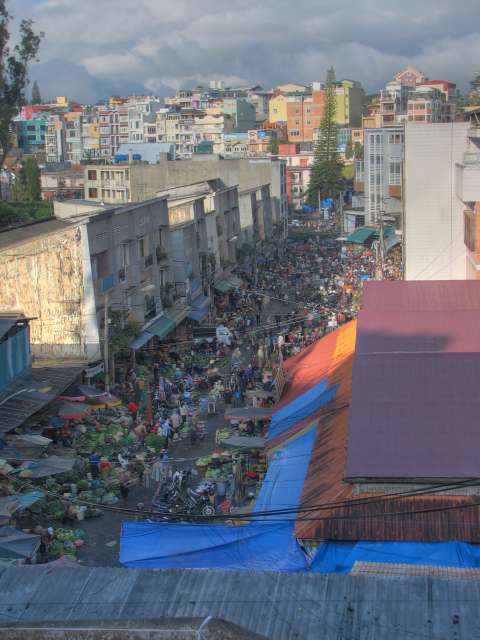
|
At Dalat Flower Garden
We saw plant sculptures such as this many places around Vietnam.
They would be quiet impractical in Australia's low humidity, too hard to stop them drying out.
|
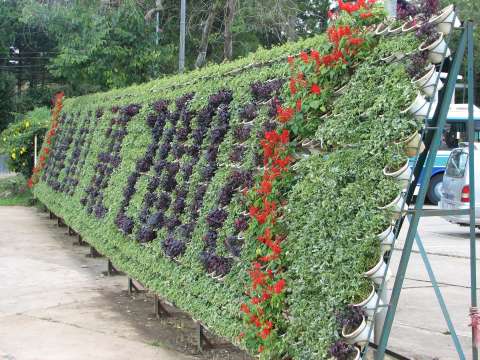
|
|
Dalat is at an altitude of 1500m.
You might think that it would be cool, but in June (summer) it is quite warm during the day; the nights are comfortably cool.
We did not have air conditioning in our hotel (Dreams 2), and found that the room was quite comfortable so long as we opened the window for an hour or more in the early evening.
See also
accommodation.
Dalat is much less on the tourist map of Westerners than the more popular of Vietnamese destinations.
On the other hand, it is one of the most popular destinations with Vietnamese
holiday makers; and the locals are not silly.
Of all the places Denece and I stayed in Vietnam in 2008, the management of Dreams 2 hotel in (Phan Dinh Phung street) Dalat, Luyen Nguyen and his mother, were the most helpful and it seemed, honest.
Both spoke good or workable English, and gave advice that seemed to be aimed to advantage us, rather than them.
The breakfasts too, at Dreams, were impossible to fault.
The front door of the hotel was opened at 0600hrs each day.
I rise early, and would have liked to go out around 0500hrs.
I mentioned this to Luyen early in our stay and he told me that all I had to do was to knock on the door to the foyer and a lad who slept there would let me out.
Although I tried this once, I didn't get any response!
There are many interesting places that can be visited both in and around Dalat.
There are a number of pagodas, a cable car ride, the Crazy House (aka Hang Nga Guesthouse ), several waterfalls, ethnic minority villages, coffee plantations, commercial flower gardens, a short and quaint train journey, a palace of the last king of Vietnam, and other attractions.
We travelled by bus from Dalat to Nha Trang.
In the vicinity of Dalat the great majority of the trees were conifers; as we travelled north broad-leaved trees began to dominate.
I inquired in Dalat about the pine trees, thinking that they seemed unlikely to be local natives, but could not get any definite answer.
It is possible that they were planted after the USians had denuded all the hills with herbicides during the war.
A hotel in Dalat.
I know little about architecture, but the style of this place looks to me to be Chinese. I find it attractive.
Unfortunately the great majority of the architecture of large buildings in Australia is very unimaginative and also unattractive. 'Big boxes' seems a fair description of much of it.
Again, some interesting and attractive architecture.
How very unfortunate that the red box has been built right up against it! A disastrous clash of styles and an affront to the eye.
The typical Vietnamese street mix of power lines do nothing for the view.
These wonderful bonsai trees would be the highlight of any garden in Australia and surely their surrounds would be tended with great care.
While the trees here have been looked after with TLC, the grass beneath them has, incongruously, been neglected.
An Australian can't help being greatly impressed with bonsai like these. It seems that they must be much easier to keep alive and thriving in the wet, warm, humid climate of Dalat than in most of Australia.
A side ally in Dalat.
I feel that it makes a pleasing composition.
As a record, the rubbish and the luxuriant growth of moss are notable.
Moss doesn't grow like this in Australia's dry climate.
What this moss says about the Dalat climate helps to explain some of the gardens.
Crazy House (aka Hang Nga Guesthouse) is well worth a visit while in Dalat.
Apparently it was designed by "Dang Viet Nga, a Ph.D. holder in architecture from Moscow State University and the daughter of a former Vietnamese president".
A Web page that gives more information about Crazy House is Strange Buildings.
A part of the gardens of Crazy House
Another view of the grounds and garden
My wife, Denece, in the Crazy House grounds
Denece and I ate at many more places than those listed below, but did not
make (decipherable) notes on them.
The simpler places aiming at the less well-off Vietnamese were extremely
cheap by Western standards, and, in our experience, had good food.
The more comfortable places, those with a door, air conditioning and with
table settings, were more expensive, but still much cheaper than you would
pay in any Western country.
Language was more likely to be problematic in the simpler places, but one
advantage was that the food was more traditionally Vietnamese.
| Restaurants in Dalat
|
|---|
| Name | Notes | Cost
|
| Vegetarian restaurant Phien Tinh Tien on 17 Huynh Thuc Khang street; near Crazy House
| Good food, great setting – you can eat in the garden or indoors if you
prefer
| 2 main cources, 2 beers, 82 000VND (~Au$5.50)
|
| Hao Vi Cafe, 219 Phan Dinh Phung
| Aimed more at locals than foreigners, good food; we ate there often
| Excellent value
|
| Trong Dong Vietnamese Restaurant, 220 Phan Dinh Phung St.
| Very good food
| More expensive than some
|
| Restaurant de Famille
| Very good food, the waitress was very chatty and informative
| Excellent value
|
Also see the note on Hoang Huy Seafood restaurant in
Quy Nhon and the Huu Nghi Restaurant in
Hoi An.
| |
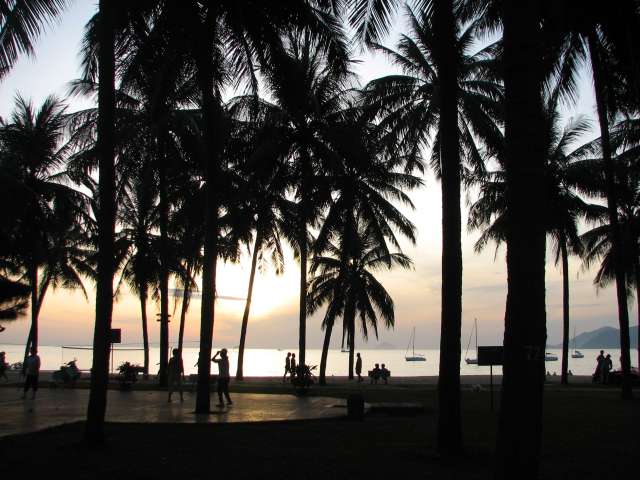
| |
Sunrise on the waterfront at Nha Trang
| |
|
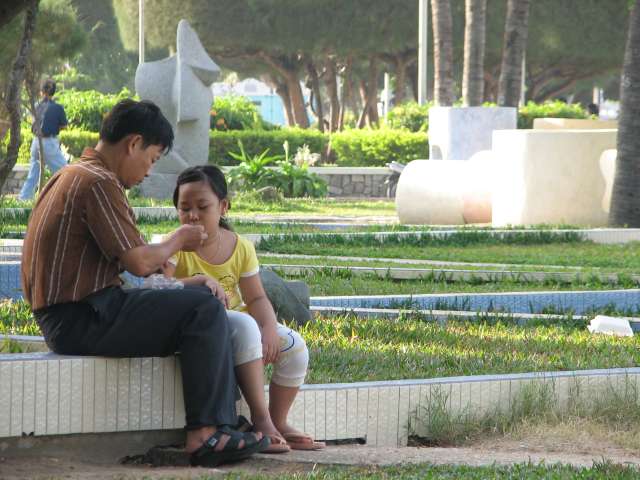
| |
In the Nha Trang sea-front park, late afternoon
| |
On the very long eastern coast, Nha Trang is a very popular beach
resort.
We visited it in 2006 and 2008.
The beach is sandy and clean, but sometimes the waves can be dumpers and
make swimming in the shallows unpleasant and getting beyond the breakers
difficult.
Still, the hotels are good and many have swimming pools.
Nha Trang is not one of our favourite places, we much preferred the
relatively undeveloped
Quy Nhon.
| |
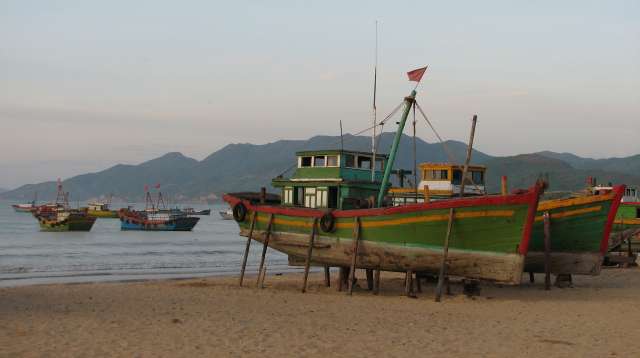
| |
Boats pulled up on the Quy Nhon beach for maintenance
| |
|

| |
An old bloke's discussion group
| |
|

| |
Getting through the surf
|
|
The part of the beach where the fishing boats are repaired is not
where you would want to go swimming.
It seems that quite a few people live on the boats, and crap on the
beach nearby – one of the facts of life in Asia.
There is a much cleaner section of the beach further along to the
east.
In July Quy Nhon is hot!
From around 1000 to 1400 hours it's best to stay inside with the air
conditioner, if you possibly can.
When you go out walk slowly, avoid the sun if you can, and have breaks
for iced coffee (I found eating the ice from the iced coffee helped to
cool me down).
The sea is cool, but if your hotel is not very close to the beach you
will be just as hot again before you get back.
I swam in Nha Trang at 1630hrs; there were hundreds of people in the water.
I swam in Quy Nhon at about 1030hrs, I was the only one in the water
in sight.
This was at least partly, I suspect, because no-one who doesn't need
to be out after 1000hrs would be – it's simply too hot.
There were many more swimmers in Quy Nhon at other times of the day.
The best restaurant that Denece and I ate at in Vietnam in 2008
was Hoang
Huy Seafood (Nha Hang), 18 Xuan Dieu (next door to Barbaras Kiwi Cafe).
The service was unbeatable, prices very low, setting great – a quiet
part of the street on the beach front – and the food was top.
(Geographic coordinates, N13.77180, E109.24121)
Also see eating.
The round basket boats are used to get from the shore to the fishing
boats.
They seem remarkably well suited for their use; they skim over the
water rather than cutting through the water as does a conventions
dinghy.
The coastal strip in this section of Vietnam is quite narrow, as can be seen by the mountains visible in the background in these photos (taken 2008/06/25).
|
|

|
A beautiful hotel (probably out of our price range) in
Hoi An.
Vietnamese architecture is much more imaginative and decorative
than is Australian.
|
|
All but the very cheapest hotels in the lower parts of the country have
air conditioned rooms; we didn't have, or need, air conditioning in our
room in Dalat (altitude 1500m).
Room prices didn't vary greatly across the country.
Of course there was hardly any limit to how much you could pay if you
wanted to, but, in general, a good room could be had for around Au$25 per
night in the more touristy places, going down to Au$10-$18 in the less
visited places (like Quy Nhon and Danang).
Breakfast is usually included in the price of the room.
This usually means a cooked breakfast if you want one, but generally you
eat so much and so well at lunch and dinner you will welcome a light
breakfast.
Many hotels provide limited Internet access at no extra charge.
Also see the note about Dreams 2 Hotel in Dalat.
| |
| Hoi An river, early morning 2008/06/30
|
|---|
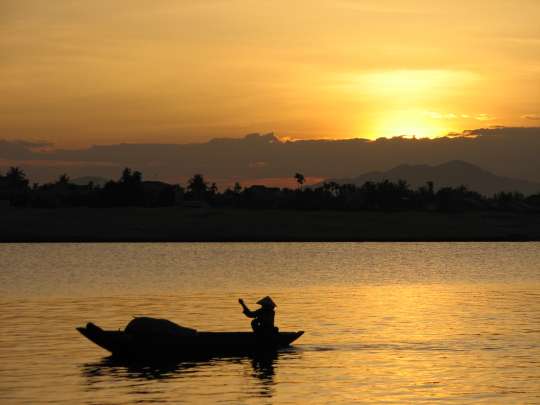
| |
A woman paddling a wooden boat on the Hoi An river in the early morning
| |
Hoi An has at least two main attractions to Western tourists.
Shopping for tailor made clothes is probably some of the best in the
world, quite probably the best in the world if you consider value for
money; and then there is the fascinating and historical architecture.
In addition, the food is excellent, a boat tour on the river is well
worth-while and can be instructive, and there is a good beach about four kilometres away.
(Jellyfish stings can be a problem at the beach.)
We were visiting Hoi An in 2008 so that we could buy clothes for my daughter's wedding which was later held in Penang, Malaysia, 1600 kilometres to the southwest. We had visited it previously, in 2006, and visited it again in 2011.
| |
| On the Hoi An river, 2008/07/05
|
|---|
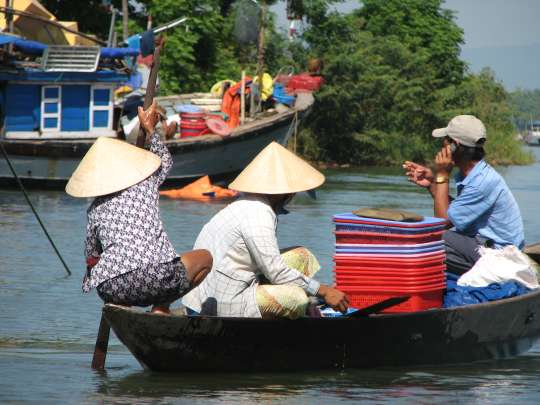
| |
Mobile phones are all the go in Vietnam too!
Note that the bloke is smoking and talking on his phone while a woman is doing the work of paddling; this seems typical.
Hoi An river
At the city the river is very much a delta, with a number of channels and many islands.
The main roads running parallel to the coast are seven kilometres and more inland, toward the west.
Consequently, there are a great many boats in use, ferries, fishing boats, tour boats.
| |
| Intricate wooden panel in the Trieu Chau Assembly Hall, 2008/07/05
|
|---|
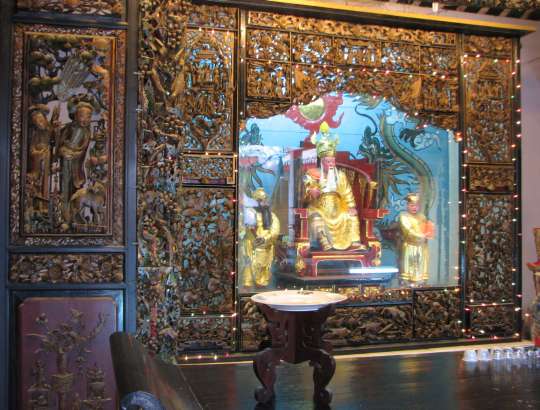
| |
We heard while we were there that Hoi An had been added to the UN
World Heritage list.
One of the best, and best value, restaurants in Hoi An in our opinion was Huu Nghi Restaurant, 56 Bach Dong Street (on the river).
Hoi An is one of the most tourist developed places in Vietnam.
| |
| On the Hoi An river, 2008/07/03
|
|---|

| |
A general view of the Hoi An waterfront in the early morning
| |
Hoi An would be nothing without the Hoi An river.
This view shows the fish market, which is open only in the early morning.
| |
| On the Hoi An river, 2008/06/28
|
|---|

| |
Captain Dan's Tour Boat
A tour boat on the Hoi An river; note the buildings in the distance.
| |
| On the Hoi An river, 2008/06/28
|
|---|

| |
The Vietnamese seem to be enthusiastic about sculptures. We saw sculpture parks in a number of places, and, of course there were many sculptures around temples and shrines.
Here the sculptures are floating on the Hoi An river.
The little thatched hut built on a boat mored adjacent to a clump of palm trees is interesting.
The baskets that this woman is washing in the river were used to contain many different things, including fish at the fish market not far from where this image was captured.
Photo taken 2008/06/28
This woman is 'stern sculling' the little boat.
Wikipedia: "Stern sculling is the process of propelling a watercraft by moving a single, stern-mounted oar from side to side while changing the angle of the blade so as to generate forward thrust on both strokes."
The technique is commonly used in Vietnam.
The mountains in the background are never far away from the coast plain in central Vietnam; the coastal plain is very flat but usually quite narrow.
Photo taken 2008/06/29
Ferries like this were kept busy taking people, bicycles, motor scooters and produce across the Hoi An river.
Note the lifebuoys and life jackets on the rack above the passengers.
Photo taken 2008/06/29
I think that this boat at it's moorings, with the tall tree in the background, made a pleasing composition.
Photo taken 2008/06/30
Loading sand onto a barge.
Machinery like this was not common in Vietnam. Labour was cheep, machinery would have been relatively very expensive, but one backhoe like this could take the place of many labourers with shovels.
Photo taken 2008/07/01
Flocks of ducks, like this, are common throughout Southeast Asia. I suppose that they have had their wings cut so that they can't fly.
The man seems to have been doing some sort of fishing while looking after the ducks.
Photo taken 2008/07/01
We did a day tour from Hoi An during which we saw this cabinet maker at work.
Holding the piece he's working on with his foot while sawing using a bow saw!
Still, no more dangerous than using power saws as Western joiners do all the time I suppose.
Photo taken 2008/07/01
On the same tour as the one in which we saw the cabinet maker we visited a potter.
Her wheel was powered by a second lady's foot.
I would suppose that the wheel would be quite heavy and its inertia would keep it spinning at a fairly constant speed.
Photo taken 2008/07/01
Further on in the tour we visited a boat builder's yard.
This boat has apparently been finished apart from whatever paint or varnish is to be applied.
It is hard to see from the photos whether the frames along the side have been made from naturally curved pieces of timber; ideally they would have been.
The boat is built in the carvel style, with the outer timbers butting against each other (as against the clinker style where they would overlap).
My Son, Ken, is on the right.
Photo taken 2008/07/01
On the right here you can see an upturned boat that has the its planking attached.
On the right just the keel that has been laid for the next boat.
Photo taken 2008/07/01
| |
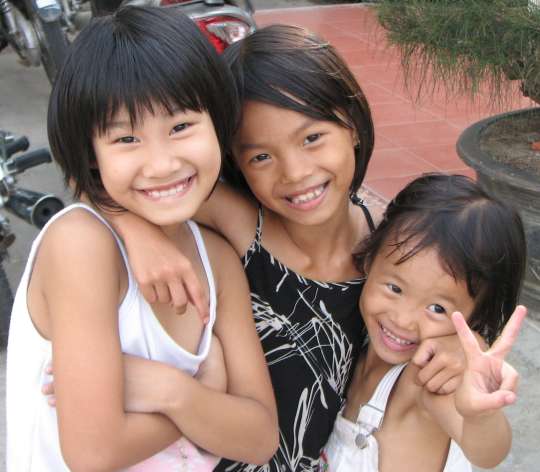
| |
Foreigners and cameras are still a novelty in Danang.
| |
| |
A narrow quintessentially Vietnamese house across the river from central Danang.
Although narrow, it was long; the length was hidden in this end-on photo.
|
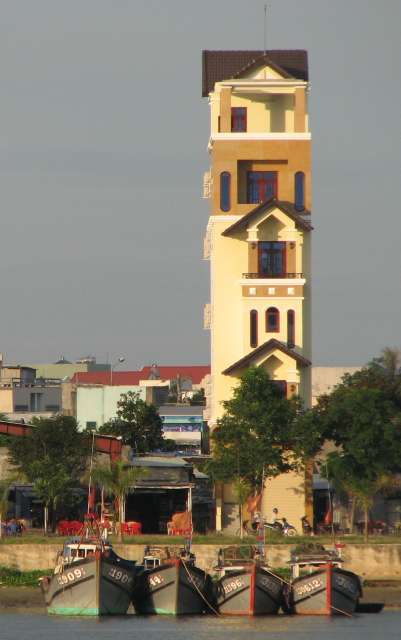
| |
Danang is only 30km from the very touristy town of Hoi An and most of
the tourists who visit Hoi An go through Danang.
Yet very few of them spend any time in Danang which, consequently, provides
a refreshing change from the tourist hordes.
The children of Danang are fascinated by Western tourists and their
cameras; they love having their photos taken and collapse into giggling
helplessness when shown the photos.
Denece and I only had a part of a day in Danang.
If we go back to Vietnam we'd like to spend more time there.
We stayed in Xuan Hung hotel, 56 Phan Chu Trihm street.
(Very good room, Au$19, including breakfast – but coffee was an extra
dollar if you wanted that at breakfast!)
It was a fairly short walk from the water-front of the river, where
many of the locals walk in the relative coolness of morning and evening.
One minor problem we had was getting out of the hotel early in the morning.
We had to wake one of the staff, who was sleeping in the reception area;
then he had to go down to the big front roller-door, bang on the door
and wake the man who was sleeping on the street in front of the door
(the big door could only be opened from the outside).
We ate dinner at a restaurant on the esplanade by the bridge (Nha hang
Sao Do, 50 Bach Dang street).
The food was excellent, and the menu exotic; it included – if I remember
rightly – horse, crocodile, ostrich, camel, and "muscle of cow".
Unfortunately we did not record the name of the restaurant.
|
|
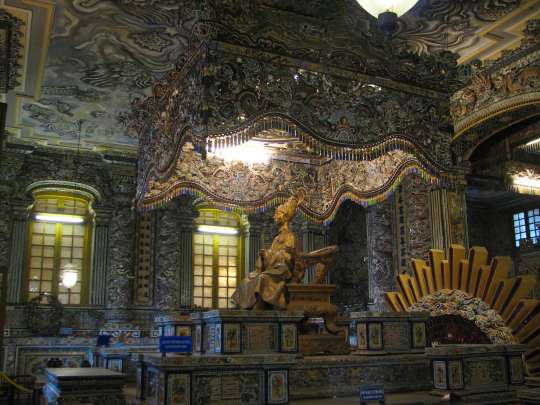
| |
Throne room of the last king of Vietnam
| |
|
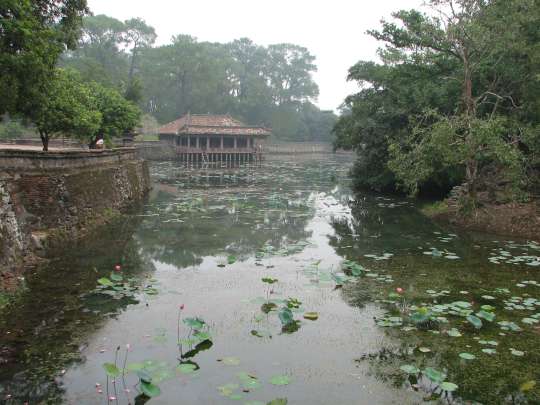
| |
A little of the grounds of one of the Hue palaces
| |
|

| |
Died sticks ready to coat with incence
|
|
Once the capital of Vietnam, there are more palaces in and around Hue
than you can poke a stick at.
Hue is also conveniently close to the Demilitarised Zone of the American
War with its restored Vinh Moc tunnels where Vietnamese lived to escape
the bombing and several important and historical American war sites.
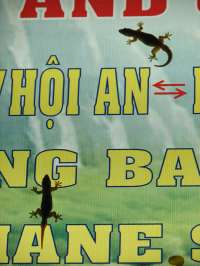
|
|
Gekkos on an illuminated sign in Hue
|
| |
The Cruse starts
|
|---|

| Which boat is 'ours'? There were a crowd of boats at the pier. I don't recall how we found the right one.
Photo 2006/10/27
| |
Halong Bay (Latitude N20.8°, Longitude E107.1°) is a maze of steep limestone islands in the north-east of the country.
It has been given World Heritage status, and is the biggest tourist
attraction in Vietnam.
When Denece and I visited with our family, June 2006, the visitor numbers were being handled without spoiling the area; I hope that remains to be the case.
Boats, service centres(?) on stilts among storybook mountains!
There are karst landscapes and mountains (geomorphology composed of limestone, which is slightly water-soluble, particularly in acidic water) in a number of places around the world. Guilin in China is one of the most famous. They are also in Kraby, Thailand and Ninh Binh, Vietnam.
